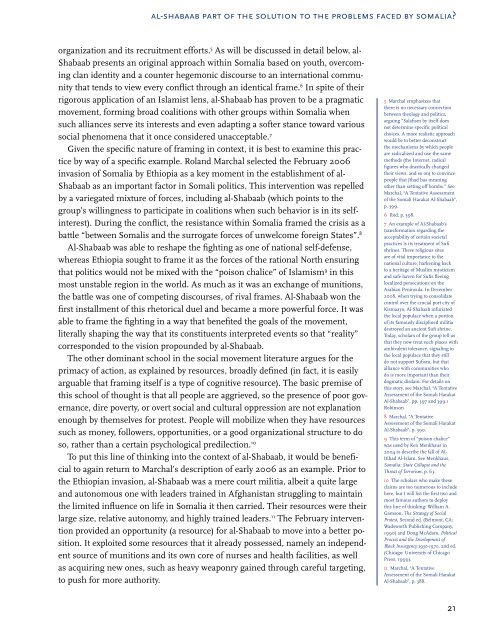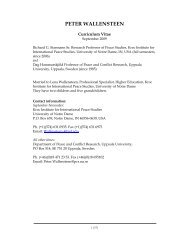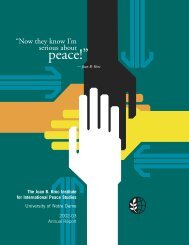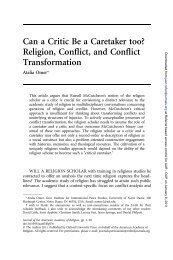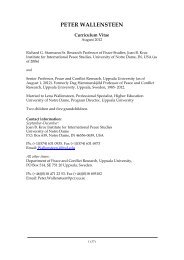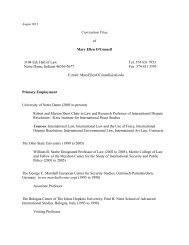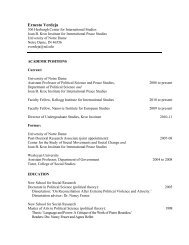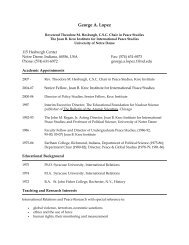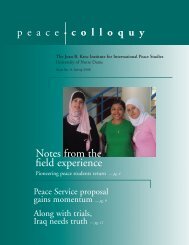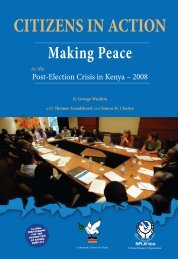Somalia: Creating Space for Fresh Approaches to Peacebuilding
Somalia: Creating Space for Fresh Approaches to Peacebuilding
Somalia: Creating Space for Fresh Approaches to Peacebuilding
Create successful ePaper yourself
Turn your PDF publications into a flip-book with our unique Google optimized e-Paper software.
al-shabaab part of the solution <strong>to</strong> the problems faced by somalia?<br />
organization and its recruitment ef<strong>for</strong>ts. 5 As will be discussed in detail below, al-<br />
Shabaab presents an original approach within <strong>Somalia</strong> based on youth, overcoming<br />
clan identity and a counter hegemonic discourse <strong>to</strong> an international community<br />
that tends <strong>to</strong> view every conflict through an identical frame. 6 In spite of their<br />
rigorous application of an Islamist lens, al-Shabaab has proven <strong>to</strong> be a pragmatic<br />
movement, <strong>for</strong>ming broad coalitions with other groups within <strong>Somalia</strong> when<br />
such alliances serve its interests and even adapting a softer stance <strong>to</strong>ward various<br />
social phenomena that it once considered unacceptable. 7<br />
Given the specific nature of framing in context, it is best <strong>to</strong> examine this practice<br />
by way of a specific example. Roland Marchal selected the February 2006<br />
invasion of <strong>Somalia</strong> by Ethiopia as a key moment in the establishment of al-<br />
Shabaab as an important fac<strong>to</strong>r in Somali politics. This intervention was repelled<br />
by a variegated mixture of <strong>for</strong>ces, including al-Shabaab (which points <strong>to</strong> the<br />
group’s willingness <strong>to</strong> participate in coalitions when such behavior is in its selfinterest).<br />
During the conflict, the resistance within <strong>Somalia</strong> framed the crisis as a<br />
battle “between Somalis and the surrogate <strong>for</strong>ces of unwelcome <strong>for</strong>eign States”. 8<br />
Al-Shabaab was able <strong>to</strong> reshape the fighting as one of national self-defense,<br />
whereas Ethiopia sought <strong>to</strong> frame it as the <strong>for</strong>ces of the rational North ensuring<br />
that politics would not be mixed with the “poison chalice” of Islamism 9 in this<br />
most unstable region in the world. As much as it was an exchange of munitions,<br />
the battle was one of competing discourses, of rival frames. Al-Shabaab won the<br />
first installment of this rhe<strong>to</strong>rical duel and became a more powerful <strong>for</strong>ce. It was<br />
able <strong>to</strong> frame the fighting in a way that benefited the goals of the movement,<br />
literally shaping the way that its constituents interpreted events so that “reality”<br />
corresponded <strong>to</strong> the vision propounded by al-Shabaab.<br />
The other dominant school in the social movement literature argues <strong>for</strong> the<br />
primacy of action, as explained by resources, broadly defined (in fact, it is easily<br />
arguable that framing itself is a type of cognitive resource). The basic premise of<br />
this school of thought is that all people are aggrieved, so the presence of poor governance,<br />
dire poverty, or overt social and cultural oppression are not explanation<br />
enough by themselves <strong>for</strong> protest. People will mobilize when they have resources<br />
such as money, followers, opportunities, or a good organizational structure <strong>to</strong> do<br />
so, rather than a certain psychological predilection. 10<br />
To put this line of thinking in<strong>to</strong> the context of al-Shabaab, it would be beneficial<br />
<strong>to</strong> again return <strong>to</strong> Marchal’s description of early 2006 as an example. Prior <strong>to</strong><br />
the Ethiopian invasion, al-Shabaab was a mere court militia, albeit a quite large<br />
and au<strong>to</strong>nomous one with leaders trained in Afghanistan struggling <strong>to</strong> maintain<br />
the limited influence on life in <strong>Somalia</strong> it then carried. Their resources were their<br />
large size, relative au<strong>to</strong>nomy, and highly trained leaders. 11 The February intervention<br />
provided an opportunity (a resource) <strong>for</strong> al-Shabaab <strong>to</strong> move in<strong>to</strong> a better position.<br />
It exploited some resources that it already possessed, namely an independent<br />
source of munitions and its own core of nurses and health facilities, as well<br />
as acquiring new ones, such as heavy weaponry gained through careful targeting,<br />
<strong>to</strong> push <strong>for</strong> more authority.<br />
5 Marchal emphasizes that<br />
there is no necessary connection<br />
between theology and politics,<br />
arguing “Salafism by itself does<br />
not determine specific political<br />
choices. A more realistic approach<br />
would be <strong>to</strong> better deconstruct<br />
the mechanisms by which people<br />
are radicalized and use the same<br />
methods (the Internet, radical<br />
figures who drastically changed<br />
their views, and so on) <strong>to</strong> convince<br />
people that Jihad has meaning<br />
other than setting off bombs.” See<br />
Marchal, “A Tentative Assessment<br />
of the Somali Harakat Al-Shabaab”,<br />
p. 399.<br />
6 Ibid, p. 398.<br />
7 An example of Al-Shabaab’s<br />
trans<strong>for</strong>mation regarding the<br />
acceptability of certain societal<br />
practices is its treatment of Sufi<br />
shrines. These religious sites<br />
are of vital importance <strong>to</strong> the<br />
national culture, harkening back<br />
<strong>to</strong> a heritage of Muslim mysticism<br />
and safe haven <strong>for</strong> Sufis fleeing<br />
localized persecutions on the<br />
Arabian Peninsula. In December<br />
2008, when trying <strong>to</strong> consolidate<br />
control over the crucial port city of<br />
Kismaayo, Al-Shabaab infuriated<br />
the local populace when a portion<br />
of its famously disciplined militia<br />
destroyed an ancient Sufi shrine.<br />
Today, scholars of the group tell us<br />
that they now treat such places with<br />
ambivalent <strong>to</strong>lerance, signaling <strong>to</strong><br />
the local populace that they still<br />
do not support Sufism, but that<br />
alliance with communities who<br />
do is more important than their<br />
dogmatic disdain. For details on<br />
this s<strong>to</strong>ry, see Marchal, “A Tentative<br />
Assessment of the Somali Harakat<br />
Al-Shabaab”, pp. 397 and 399.1<br />
Robinson<br />
8 Marchal, “A Tentative<br />
Assessment of the Somali Harakat<br />
Al-Shabaab”, p. 390.<br />
9 This term of “poison chalice”<br />
was used by Ken Menkhaus in<br />
2004 <strong>to</strong> describe the fall of Al-<br />
Itihad Al-Islam. See Menkhaus,<br />
<strong>Somalia</strong>: State Collapse and the<br />
Threat of Terrorism, p. 63.<br />
10 The scholars who make these<br />
claims are <strong>to</strong>o numerous <strong>to</strong> include<br />
here, but I will list the first two and<br />
most famous authors <strong>to</strong> deploy<br />
this line of thinking: William A.<br />
Gamson, The Strategy of Social<br />
Protest, Second ed. (Belmont, CA:<br />
Wadsworth Publishing Company,<br />
1990) and Doug McAdam, Political<br />
Process and the Development of<br />
Black Insurgency 1930-1970, 2nd ed.<br />
(Chicago: University of Chicago<br />
Press, 1999).<br />
11 Marchal, “A Tentative<br />
Assessment of the Somali Harakat<br />
Al-Shabaab”, p. 388.<br />
21


